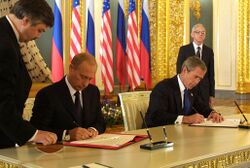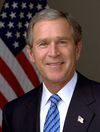معاهدة خفض الأسلحة الهجومية الاستراتيجية
| Treaty on Strategic Offensive Reductions | |
|---|---|
 الرئيسان ڤلاديمير پوتن وجورج و. بوش يوقعان SORT في 24 مايو 2002 في موسكو | |
| النوع | نزع السلاح النووي الاستراتيجي |
| وُقـِّعت | 24 مايو 2002 |
| المكان | موسكو |
| سارية منذ | 1 يونيو 2003 |
| الحالة | تصديق الطرفين |
| انتهاء الصلاحية | 5 فبراير 2011 (Superseded by New START) |
| الموقعون | الولايات المتحدة: جورج و. بوش روسيا: ڤلاديمير پوتن |
| الأطراف | |
| المصدقون | مجلس الشيوخ الأمريكي دوما الدولة |
| اللغات | الإنگليزية، الروسية |
المعاهدة بين الولايات المتحدة والاتحاد الروسي حول خفض الأسلحة الهجومية الاستراتيجية (SORT)، وتـُعرَف أيضاً بإسم معاهدة موسكو، كانت strategic arms reduction treaty between the United States and Russia that was in force from June 2003 until February 2011 when it was superseded by the New START treaty.[1]
At the time, SORT was positioned as "represent[ing] an important element of the new strategic relationship" between the two countries[2] with both parties agreeing to limit their nuclear arsenal to between 1,700 and 2,200 operationally deployed warheads each. It was signed in Moscow on 24 May 2002.
After ratification by the U.S. Senate and the State Duma, SORT came into force on 1 June 2003. It would have expired on 31 December 2012 if not superseded by New START. Either party could have withdrawn from the treaty upon giving three months written notice to the other.
نزع السلاح النووي المتبادل
SORT was one in a long line of treaties and negotiations on mutual nuclear disarmament between Russia (and its predecessor, the Soviet Union) and the United States, which includes SALT I (1969–1972), the ABM Treaty (1972), SALT II (1972–1979), the INF Treaty (1987), START I (1991), START II (1993) و New START (2010).
The Moscow Treaty was different from START in that it limited operationally deployed warheads, whereas START I limited warheads through declared attribution to their means of delivery (ICBMs, SLBMs, and Heavy Bombers).[3]
Russian and U.S. delegations met twice a year to discuss the implementation of the Moscow Treaty at the Bilateral Implementation Commission (BIC).
التصديق
قـُدِّمت المعاهدة للتصديق في ديسمبر 2002. إلا أن تمرير الاتفاقية استغرق نحو عام لأن مشروع القانون كان عليه أن يعاد تقديمه بعد رفضه في اللجنة بسبب مخاوف حول تمويل القوات النووية وحول خفض الأنظمة التي لم تبلغ بعد عـُمر نهاية خدمتها. Further, the deputies were concerned about the U.S.'s ability to upload reserve nuclear warheads for a first strike (upload potential).
The ratification was also problematic because the chairman of the foreign affairs committee of the Duma, Dmitry Rogozin, disagreed with his Federation Council counterpart Margelov. Deputy Rogozin argued that the Moscow Treaty should be delayed because of the 2003 U.S. invasion of Iraq. In the end, however, this delay never happened. The final vote was similar to START II with nearly a third of the deputies voting against. The ratification resolution mandated presidential reporting on nuclear force developments and noted that key legislators should be included in interagency planning.
التنفيذ
Lawrence Livermore National Laboratory reported that President Bush directed the US military to cut its stockpile of both deployed and reserve nuclear weapons in half by 2012. The goal was achieved in 2007, a reduction of US nuclear warheads to just over 50 percent of the 2001 total. A further proposal by Bush would have brought the total down another 15 percent.[4]
انتقادات
While President Bush said the treaty "liquidates the Cold War legacy of nuclear hostility" and his security advisor Condoleezza Rice said it should be considered "the last treaty of the last century,"[5] others criticized the treaty for various reasons:
- There were no verification provisions to give confidence, to either the signatories or other parties, that the stated reductions have in fact taken place.
- The arsenal reductions were not required to be permanent; warheads are not required to be destroyed and may therefore be placed in storage and later redeployed.
- The arsenal reductions were required to be completed by 31 December 2012, which is also the day on which the treaty loses all force unless extended by both parties.
- There was a clause in the treaty which provided that withdrawal can occur upon the giving of three months' notice and since no benchmarks are required in the treaty, either side could feasibly perform no actions in furtherance of the treaty and then withdraw in September 2012.[بحاجة لمصدر]
انظر أيضاً
- هناك العديد من المعاهدات الأخرى تـُعرف بإسم معاهدة موسكو
- Russia and weapons of mass destruction
- United States and weapons of mass destruction
- معاهدة نيو ستارت
للاستزادة
- Nuclear Files.org Archived 18 أبريل 2009 at the Wayback Machine Text of the SORT
الهامش
- ^ Obama, Barack (2010-05-13). "Memo to the Senate of the United States" (PDF). White House Office of the Press Secretary. Archived from the original (PDF) on 2010-05-28.
- ^ Letter of Transmittal: The Moscow Treaty 2002
- ^ START1 treaty hypertext US State Dept. Article II
- ^ Heller, Anne (2008-07-08). "Monitoring a Nuclear Weapon from the Inside: Embedded sensors could help transform stockpile stewardship". Science & Technology Review. Lawrence Livermore National Laboratory. Archived from the original on 2008-09-20.
- ^ Sanger, David E.; Wines, Michael (2002-05-24). "U.S. and Russia Sign Nuclear Weapons Reduction Treaty (Published 2002)". The New York Times (in الإنجليزية الأمريكية). ISSN 0362-4331. Retrieved 2020-11-07.
- CS1 الإنجليزية الأمريكية-language sources (en-us)
- Short description matches Wikidata
- Articles with hatnote templates targeting a nonexistent page
- Missing redirects
- المقالات needing additional references from November 2020
- كل المقالات needing additional references
- Articles with unsourced statements from November 2020
- معاهدات الحد من التسلح
- أسلحة نووية
- معاهدات الولايات المتحدة
- 2003 في روسيا
- 2003 في الولايات المتحدة
- حوكمة الأسلحة النووية
- العلاقات الأمريكية الروسية
- معاهدات أبرمت في 2002
- معاهدات دخلت حيز التنفيذ في 2003
- معاهدات روسيا
- السياسة الخارجية لإدارة جورج و. بوش
- ڤلاديمير پوتن
- معاهدات التكنولوجيا النووية


